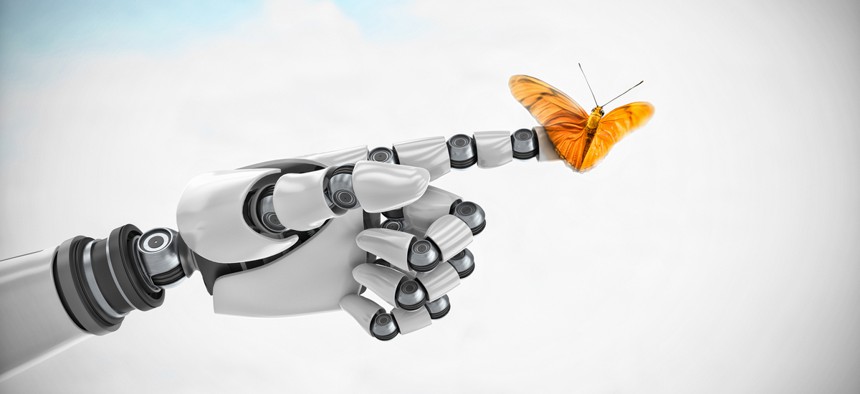What Robots Need to Become Better Helpers

vectorfusionart/Shutterstock.com
Hand, fingers and a sense of touch are tricky but may be essential for some robots' tasks.
Both the government and private sector continue to work on building more functional robots to accomplish various tasks, especially ones that aren’t suited or safe for humans. For example, NASA’s Mars Perseverance Mission, which is fully robotic, is scheduled to make planetfall on Mars next week. In addition to the Pathfinder robot, which is pretty well-known at this point, it will also be carrying the Ingenuity Mars Helicopter, a robotic drone specially designed to fly around and explore within the thin atmosphere of Mars.
But mobility is only one aspect of creating the advanced robots and robotic tools of the future. For the most part, we have the locomotion part down. We already have thousands of flying drones and robots, plus specialized models that can climb up the side of cliffs or work completely in or under the water.
The problem is that once we get those robots into inaccessible or inhospitable places, they need to be able to actually manipulate their environment in the same way that a human would. And for that, they pretty much need hands, ideally ones with fingers and maybe a thumb. I recently talked with a researcher at the Army Research Laboratory who told me that the ability to manipulate physical space, through either some type of actuator or robotic hand, would be an important key to successful robot deployments in the future.
Last week, we got a first look at what that might look like. Boston Dynamics, one of the most advanced robot-making companies in the world, upgraded their well-known dog-like robot model named Spot with a very functional robotic hand. Previously, Spot robots were able to traverse rough terrain and even stairs but were stymied by things like a closed door. The company released a fascinating video showing Spot making good use of its new appendage. The hand is mounted on the end of an articulated arm in the center of the robot which lets it extend in almost any direction.
“Since first launching Spot, we have worked closely with our customers to identify how the robot could best support their mission-critical applications,” said Robert Playter, CEO of Boston Dynamics. “Our customers want reliable data collection in remote, hazardous and dynamic worksites. We developed the new Spot products with these needs in mind, and with the goal of making it easy to regularly and remotely perform critical inspections, improving safety and operations.”
The video shows Spot performing some very fine manipulations with its hand, including planting a sapling (after first digging a hole for it) without snapping the delicate young tree in half. It also does some other tasks in the video including collecting a bundle of cloth out in the snowy woods, opening an office door and shutting off a valve to stop a leaking pipe. All of that is impressive, but one wonders just how delicate Spot, or any robot, can really be without a real sense of touch.
It’s a question that Professor Ted Adelson of the Massachusetts Institute of Technology Computer Science and Artificial Intelligence Laboratory has been working on for many years. He has designed a way for robots to simulate a sense of touch, which he believes will eventually enable them to be as precise as a human hand.
“In order for robots to do good manipulation, they need good fingers,” he said. “We’re trying to make fingers that can match the capabilities of human fingers.”
The technology that Adelson and the team at MIT developed is called GelSight, and it involves deploying a soft covering over a robotic hand. Tiny cameras in the material monitor the surrounding soft “skin” and record how much it deforms as the hand grips objects. That data is then fed into a computer model that helps the robot “see” how much pressure is needed to grasp an object without squeezing it too hard. The fingers can also be used to measure force, shear and slip.
He talked about this new technology and its importance in an interview posted on YouTube last month. From his explanation, it seems like the next step is making sure that robots can use the collected touch data intelligently with their new hands so they can accomplish a variety of tasks requiring everything from brute strength to fine motor skills.
Of course, the other thing that our robots need to help usher in the future is the ability to perform tasks independently without human interaction. Technically, the definition of a robot is a device that can carry out complex actions automatically. So having a human piloting a device’s every move means that it’s not technically a robot at all. But we are working on that too, with great strides in artificial intelligence and machine learning being made every day.
It’s just that when working on something as complex and powerful as creating artificial intelligence, it’s easy to forget little things, like the power and the necessity of touch. Hopefully, we are starting to see the tip of the iceberg now in that new area of artificial senses, with future robots literally getting a helping hand from the latest research.
John Breeden II is an award-winning journalist and reviewer with over 20 years of experience covering technology. He is the CEO of the Tech Writers Bureau, a group that creates technological thought leadership content for organizations of all sizes. Twitter: @LabGuys
NEXT STORY: Data Must Lead the Way to Reopening Our Schools






